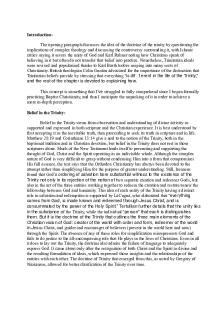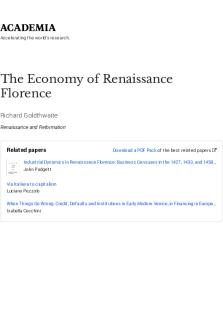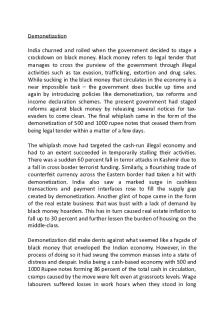Indian Economy Notes - summary of the nehru era chapter PDF

| Title | Indian Economy Notes - summary of the nehru era chapter |
|---|---|
| Author | shubham kumar |
| Course | Indian Economy |
| Institution | University of Delhi |
| Pages | 2 |
| File Size | 56.9 KB |
| File Type | |
| Total Downloads | 7 |
| Total Views | 144 |
Summary
summary of the nehru era chapter...
Description
INDIAN ECONOMY NEHRU’S ERA WHAT THE PAPER CONSIST: 1: This paper investigates the relationship between the policy regime and economic growth in India over the period 1950-64 which Pulapre Balakrishnan term as ‘’THE NEHRU ERA’’. Recall that this spans the interval between the formation of the Planning Commission and the death in office of Jawaharlal Nehru. 2: In Balkrishnan’s opinion, economic policymaking in Nehru era was relatively free of narrow political considerations, the economic goals adopted were independent of economic vested interests and the political imperatives of Westminster style democracy the hallmark of which is party politics. 3: According to Balakrishnan, taking on the entire 20th century a shift in the growth of GDP (a) He feels that it may comes as a surprise to some that the most significant break in terms of economics growth of the century is found to be created around 1950 and thus policies of the era may provide us with pointers for future growth. (b) Secondly, as it was also a period of ’’high state directedness ‘’, it enables us to assess how, if at all, such intervention can facilitate growth and how it can hold it back. In the context of the expected to have an audience beyond those interested in the recent history of India. NEHRU MAHALANOBIS STRATEGY: 1: ‘’Mahalanobis model’’ which appeared in an assay by him in Sankhya –the Indian journal of statistics in 1995 (a) The model was intended to provide the analytical foundation for the project of raising the level of income via industrialization already deliberated upon in the National Planning Committee of the Congress which chaired by Nehru at the request of Shubhash Chandra Bose in his capacity to as the Nehru Mahalanobis strategy. (b) This was a model to serve the end of rapidly raising the level of income through accelerating growth, as raising the level of income was considered the means to eliminating poverty. 2: Mahalanobis had conceived of an economy with two sectors, producing capital and consumer goods (a) The model assumes the closed economy so the output would thus sum up to GDP or national income. Y=C+I (b) The capital good enters into the production of the consumer itself. (c) From the economic theory of time, the assumption was taken that capital was not subjected to diminishing returns.
(c1) we have to invest in the capital sector due to which there will be a higher level of income generation because capital good sector has inc. returns but only in long run and then we have to invest the profit into consumer good sector. (c2) Inc. in capital good sector’s investment---higher returns---higher profit---higher investment in consumer good sector [for eg. We can’t make tractor without steel] 5: Balakrishnan says that it is important to understand the practical aspects of the strategy. THE HEAVY GOODS SECTOR: 1: This strategy was a fast growing ’’heavy-goods’’ sector and these heavy goods are described as ‘’machine-building complexes with a large capacity for the manufacture of machinery to produce steel, chemicals, fertilizers, electricity, transport equipment etc’’. 2: Thus we have to first invest in the capital goods sector acc. to Nehru so either we can export them but this lead to diseq.in the BOP or we can produce our own goods (self reliance). Thus all the steel plants was established during Nehru’s time like DURGAPUR STEEL PLANT, BHILAI STEEL PLANT, etc. To establish a plant, a infrastructure (roads,water,brigdes,labor,hospital,clinic,market) was developed which led to the economic growth. But this model also has loop holes: (1) SUPPLY SIDE MODEL: Supply side model means that this model only explains that how and by whom investment is to be done (which is gvt.). Thus there is no pvt. Ownership. Thus: Investment is done---inc. in employment---inc. in purchasing power This model gives money into hands (supply side) by reinvesting via industrialisation (2) DEMAND SIDE MODEL: *Which depends on consumers what is demand side model :for eg.consumers already have shoes but there is a supply of shoes by produc^n of it in the market so there will be a fake demand created by giving discounts. Thus by creating atmosphere, demand created. Thus both, supply side model and demand side model is targeting consumers, one by giving money into the hands and one by creating fake demand....
Similar Free PDFs

Chapter 1 indian economy
- 16 Pages

Indian- Economy-1
- 21 Pages

The Global Economy Notes
- 25 Pages

Nehru ppi notes are
- 4 Pages

Chapter 22 The Token Economy
- 9 Pages

Chapter+7+The+Royal+Era
- 2 Pages

Trinity - Summary of the chapter
- 4 Pages

Indian Economy MCQ 2 - IE mcq
- 5 Pages
Popular Institutions
- Tinajero National High School - Annex
- Politeknik Caltex Riau
- Yokohama City University
- SGT University
- University of Al-Qadisiyah
- Divine Word College of Vigan
- Techniek College Rotterdam
- Universidade de Santiago
- Universiti Teknologi MARA Cawangan Johor Kampus Pasir Gudang
- Poltekkes Kemenkes Yogyakarta
- Baguio City National High School
- Colegio san marcos
- preparatoria uno
- Centro de Bachillerato Tecnológico Industrial y de Servicios No. 107
- Dalian Maritime University
- Quang Trung Secondary School
- Colegio Tecnológico en Informática
- Corporación Regional de Educación Superior
- Grupo CEDVA
- Dar Al Uloom University
- Centro de Estudios Preuniversitarios de la Universidad Nacional de Ingeniería
- 上智大学
- Aakash International School, Nuna Majara
- San Felipe Neri Catholic School
- Kang Chiao International School - New Taipei City
- Misamis Occidental National High School
- Institución Educativa Escuela Normal Juan Ladrilleros
- Kolehiyo ng Pantukan
- Batanes State College
- Instituto Continental
- Sekolah Menengah Kejuruan Kesehatan Kaltara (Tarakan)
- Colegio de La Inmaculada Concepcion - Cebu







